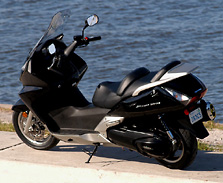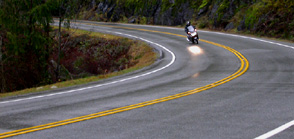
|
|
||||||||
REDEFINING THE SCOOTER?
 |
Honda's Silverwing 600 Photo: Honda Canada |
Okay, how do you define what a scooter is? It used to be quite simple when the majority of them were twist-and-go, two-stroke fifties that all pretty much looked the same. But with the recent appearance of the so-called maxi-scooter and their ever-rising engine sizes, what defines a scooter and where it fits in the world of motorcycles has shifted.
The first thing that you have to get your head around when it comes to big scooters is that they're not just odd-shaped motorcycles. Automatic transmission, step-through frame, smaller wheels, large underseat storage area and an upright riding position are all defining elements of scooters, but some of these factors can also be limiting.
For starters, the mere fact that you have a twist-and-go throttle set-up (with some power behind it) is quite unique. You're riding an automatic, and (much like in the four-wheeled world), it's a very different beast. In fact, I wonder if someone who learns to ride on a big-scooter would have a tough time switching to a “foot-shift” bike, as we have with auto to stick-shift cars?
 |
| Yamaha's Majesty 400. |
The twist-and-go set-up means that both brakes are now on the handlebars, leaving your feet with nothing to do other than tap along to the songs churning around in your head. Interestingly, it's the conventional foot-shifting motorcyclist that has to do some learning here, as a pulling in of the ‘clutch' now results in rear brake lock-up! You'll do it at least once or twice to start … trust me on that one.
But where the biggest difference is, is not in the mechanics, but the style. I found it very interesting at the recent Honda launch in Miami that they suggested that their new 600 Silverwing scooter could be viewed as more of a sport-tourer than scooter. I can understand them wanting to make that mental leap, as when looked at as a big scoot, there's a big risk of sticker shock on behalf of the prospective buyer – a tad over ten grand isn't so high when it's considered a sports-tourer.
 |
| Cornering at speed can be tricky. |
However, the suggestion is a valid one — as a big-engined scoot is quite capable of actual touring — but does it have the sporty capability too? From my experience so far, I would have to say no.
Riding a Yamaha Majesty up B.C.'s Sunshine Coast put to rest the suggestion that a big-scoot can be sporty, simply because there's nothing in the middle to hold on to. Even if you're not the knee-down type, you're probably doing some reshuffling of mass whenever you ramp it up a little in the twisty stuff, and having something to clasp onto helps you do this!
 |
Piaggio's X9. Photo: Piaggio |
As a result, when you're coming into a corner at speed you're left with no choice but to sit bolt-upright and lean the bike hard to get the required balance between tilt, speed and curvature. It can be made to work, but you either have to really think each corner or just not get too sporty. Add to that reduced feedback from the bike and less stability thanks to the smaller wheels, and the sport factor is severely limited. Well, compared to ‘real' sport-tourers anyway.
But this is not a problem (as long as you're not finding this out as the chassis is grinding out and the wheels are lifting off the ground in mid-corner), because the big-scoot is a very usable vehicle. Great weather protection, simple controls and built-in storage, make it what it is and will surely appeal to a segment of potential motorcyclists that have not yet found their perfect ride.
As long as they're ridden within their limits and taken for what they are, they fill a niche in the spectrum of two-wheels. Just don't try to keep up with the race-rep crowd or you're likely to end up in the rhubarb!
![]()